ACFI3004 Taxation: Determining Australian Tax Residency - Trimester 2
VerifiedAdded on 2023/06/09
|5
|1363
|115
Case Study
AI Summary
This document presents a detailed analysis of a taxation case study focusing on determining the Australian tax residency status of a 22-year-old Singaporean actress, Prinnah, who accepted a nine-month contract with an Australian movie production company. The analysis considers various factors, including the duration of stay, purpose of visit, and social arrangements, referencing relevant sections of the ITAA 1936 and ITAA 1997, as well as income tax rulings and case law such as FC of T v. Pechey. It concludes that Prinnah would likely be considered an Australian tax resident for the year ending June 30, 2018, and discusses the implications of this status on her assessable income and tax obligations, including the applicability of resident tax rates and Medicare levy.
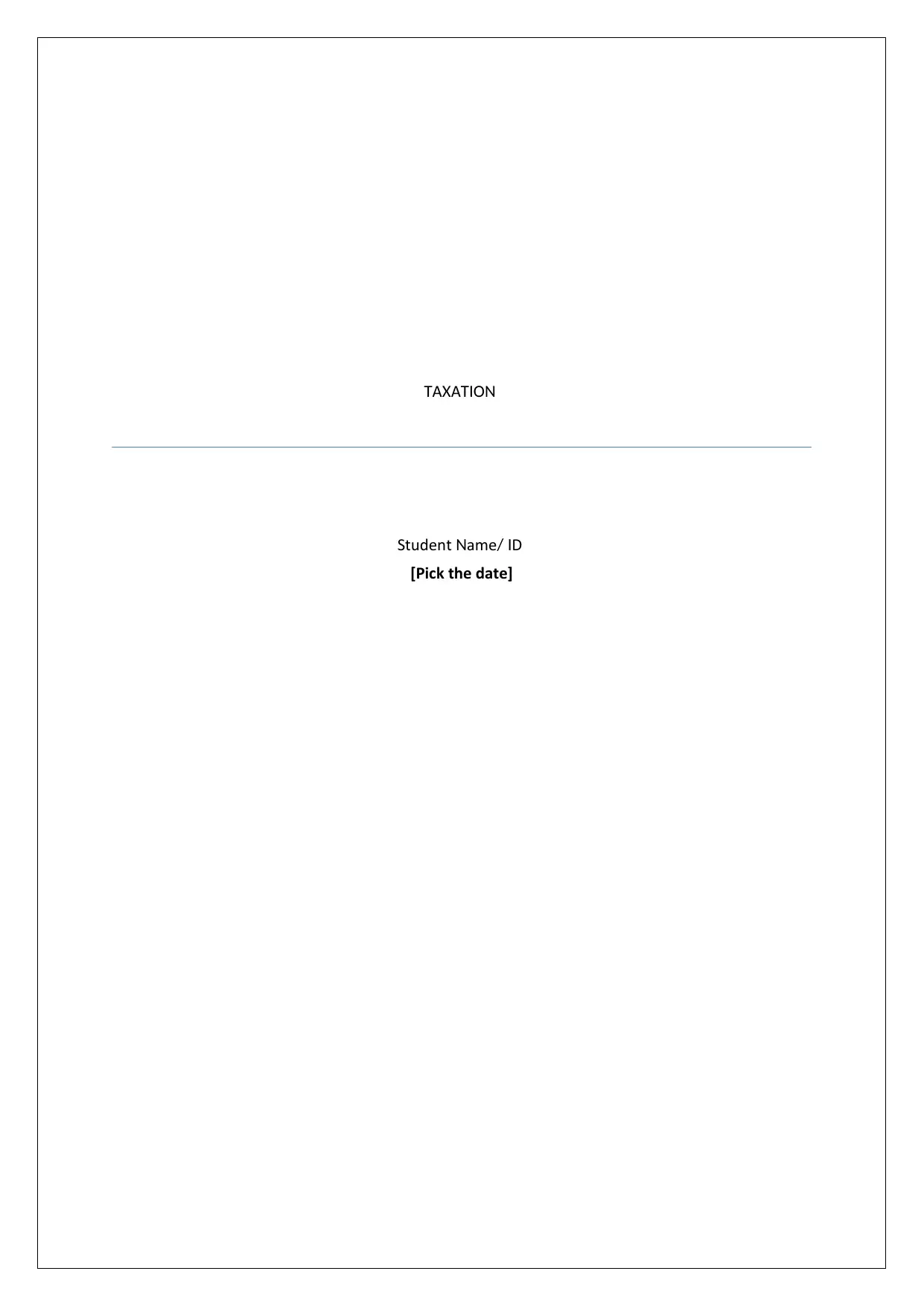
A AT X TION
Student ame DN / I
[Pick the date]
Student ame DN / I
[Pick the date]
Paraphrase This Document
Need a fresh take? Get an instant paraphrase of this document with our AI Paraphraser
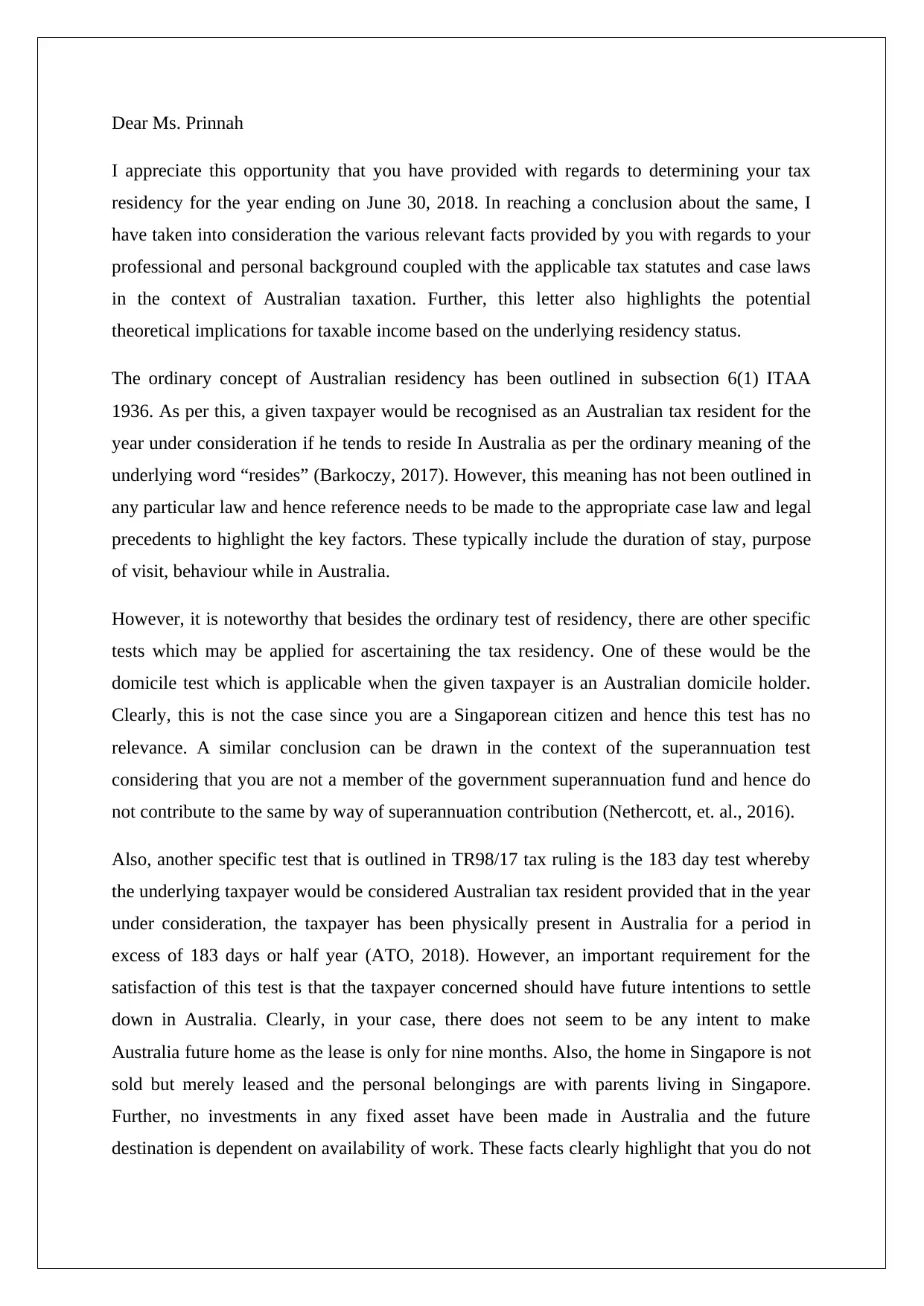
Dear Ms. Prinnah
I appreciate this opportunity that you have provided with regards to determining your tax
residency for the year ending on June 30, 2018. In reaching a conclusion about the same, I
have taken into consideration the various relevant facts provided by you with regards to your
professional and personal background coupled with the applicable tax statutes and case laws
in the context of Australian taxation. Further, this letter also highlights the potential
theoretical implications for taxable income based on the underlying residency status.
The ordinary concept of Australian residency has been outlined in subsection 6(1) ITAA
1936. As per this, a given taxpayer would be recognised as an Australian tax resident for the
year under consideration if he tends to reside In Australia as per the ordinary meaning of the
underlying word “resides” (Barkoczy, 2017). However, this meaning has not been outlined in
any particular law and hence reference needs to be made to the appropriate case law and legal
precedents to highlight the key factors. These typically include the duration of stay, purpose
of visit, behaviour while in Australia.
However, it is noteworthy that besides the ordinary test of residency, there are other specific
tests which may be applied for ascertaining the tax residency. One of these would be the
domicile test which is applicable when the given taxpayer is an Australian domicile holder.
Clearly, this is not the case since you are a Singaporean citizen and hence this test has no
relevance. A similar conclusion can be drawn in the context of the superannuation test
considering that you are not a member of the government superannuation fund and hence do
not contribute to the same by way of superannuation contribution (Nethercott, et. al., 2016).
Also, another specific test that is outlined in TR98/17 tax ruling is the 183 day test whereby
the underlying taxpayer would be considered Australian tax resident provided that in the year
under consideration, the taxpayer has been physically present in Australia for a period in
excess of 183 days or half year (ATO, 2018). However, an important requirement for the
satisfaction of this test is that the taxpayer concerned should have future intentions to settle
down in Australia. Clearly, in your case, there does not seem to be any intent to make
Australia future home as the lease is only for nine months. Also, the home in Singapore is not
sold but merely leased and the personal belongings are with parents living in Singapore.
Further, no investments in any fixed asset have been made in Australia and the future
destination is dependent on availability of work. These facts clearly highlight that you do not
I appreciate this opportunity that you have provided with regards to determining your tax
residency for the year ending on June 30, 2018. In reaching a conclusion about the same, I
have taken into consideration the various relevant facts provided by you with regards to your
professional and personal background coupled with the applicable tax statutes and case laws
in the context of Australian taxation. Further, this letter also highlights the potential
theoretical implications for taxable income based on the underlying residency status.
The ordinary concept of Australian residency has been outlined in subsection 6(1) ITAA
1936. As per this, a given taxpayer would be recognised as an Australian tax resident for the
year under consideration if he tends to reside In Australia as per the ordinary meaning of the
underlying word “resides” (Barkoczy, 2017). However, this meaning has not been outlined in
any particular law and hence reference needs to be made to the appropriate case law and legal
precedents to highlight the key factors. These typically include the duration of stay, purpose
of visit, behaviour while in Australia.
However, it is noteworthy that besides the ordinary test of residency, there are other specific
tests which may be applied for ascertaining the tax residency. One of these would be the
domicile test which is applicable when the given taxpayer is an Australian domicile holder.
Clearly, this is not the case since you are a Singaporean citizen and hence this test has no
relevance. A similar conclusion can be drawn in the context of the superannuation test
considering that you are not a member of the government superannuation fund and hence do
not contribute to the same by way of superannuation contribution (Nethercott, et. al., 2016).
Also, another specific test that is outlined in TR98/17 tax ruling is the 183 day test whereby
the underlying taxpayer would be considered Australian tax resident provided that in the year
under consideration, the taxpayer has been physically present in Australia for a period in
excess of 183 days or half year (ATO, 2018). However, an important requirement for the
satisfaction of this test is that the taxpayer concerned should have future intentions to settle
down in Australia. Clearly, in your case, there does not seem to be any intent to make
Australia future home as the lease is only for nine months. Also, the home in Singapore is not
sold but merely leased and the personal belongings are with parents living in Singapore.
Further, no investments in any fixed asset have been made in Australia and the future
destination is dependent on availability of work. These facts clearly highlight that you do not
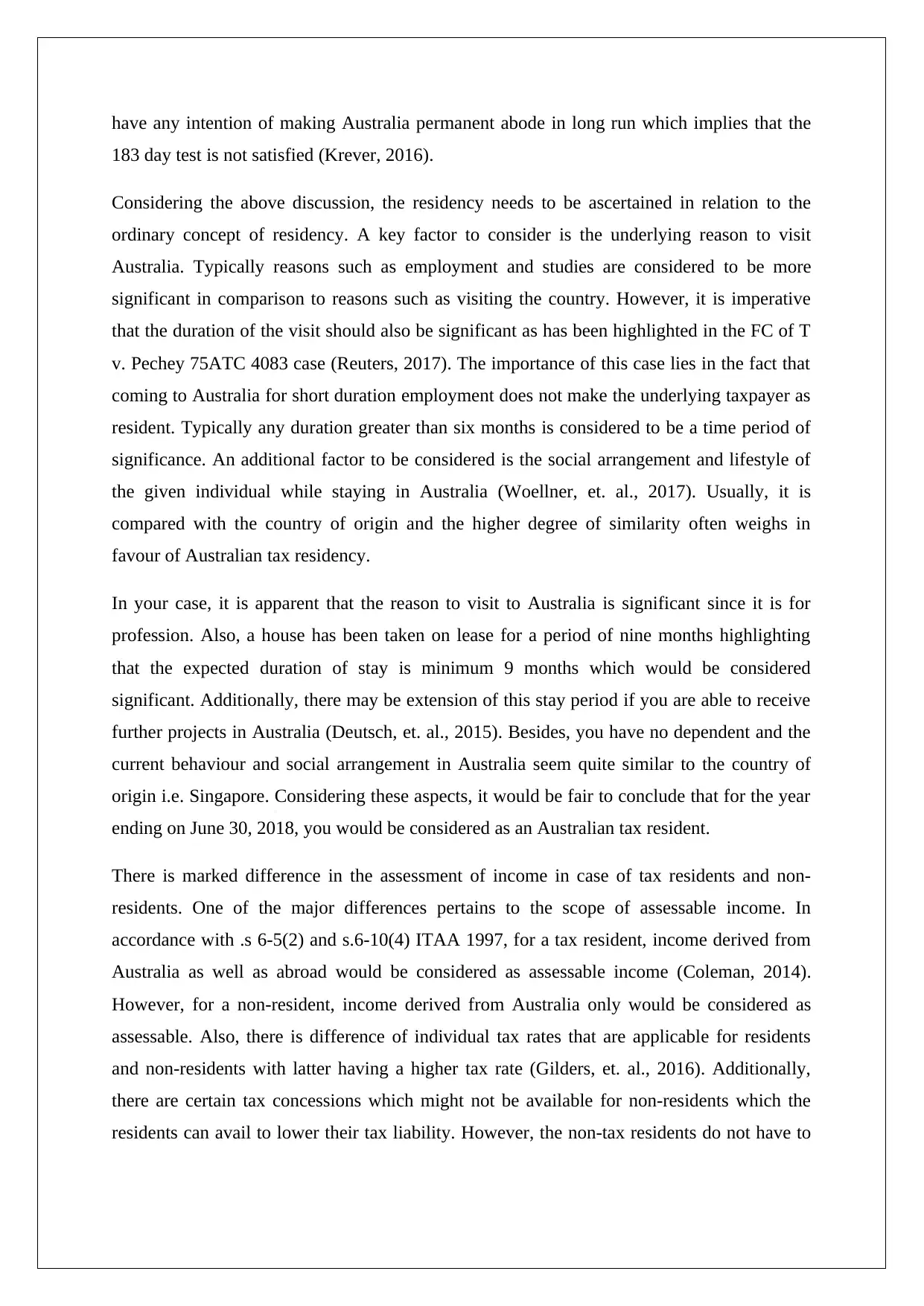
have any intention of making Australia permanent abode in long run which implies that the
183 day test is not satisfied (Krever, 2016).
Considering the above discussion, the residency needs to be ascertained in relation to the
ordinary concept of residency. A key factor to consider is the underlying reason to visit
Australia. Typically reasons such as employment and studies are considered to be more
significant in comparison to reasons such as visiting the country. However, it is imperative
that the duration of the visit should also be significant as has been highlighted in the FC of T
v. Pechey 75ATC 4083 case (Reuters, 2017). The importance of this case lies in the fact that
coming to Australia for short duration employment does not make the underlying taxpayer as
resident. Typically any duration greater than six months is considered to be a time period of
significance. An additional factor to be considered is the social arrangement and lifestyle of
the given individual while staying in Australia (Woellner, et. al., 2017). Usually, it is
compared with the country of origin and the higher degree of similarity often weighs in
favour of Australian tax residency.
In your case, it is apparent that the reason to visit to Australia is significant since it is for
profession. Also, a house has been taken on lease for a period of nine months highlighting
that the expected duration of stay is minimum 9 months which would be considered
significant. Additionally, there may be extension of this stay period if you are able to receive
further projects in Australia (Deutsch, et. al., 2015). Besides, you have no dependent and the
current behaviour and social arrangement in Australia seem quite similar to the country of
origin i.e. Singapore. Considering these aspects, it would be fair to conclude that for the year
ending on June 30, 2018, you would be considered as an Australian tax resident.
There is marked difference in the assessment of income in case of tax residents and non-
residents. One of the major differences pertains to the scope of assessable income. In
accordance with .s 6-5(2) and s.6-10(4) ITAA 1997, for a tax resident, income derived from
Australia as well as abroad would be considered as assessable income (Coleman, 2014).
However, for a non-resident, income derived from Australia only would be considered as
assessable. Also, there is difference of individual tax rates that are applicable for residents
and non-residents with latter having a higher tax rate (Gilders, et. al., 2016). Additionally,
there are certain tax concessions which might not be available for non-residents which the
residents can avail to lower their tax liability. However, the non-tax residents do not have to
183 day test is not satisfied (Krever, 2016).
Considering the above discussion, the residency needs to be ascertained in relation to the
ordinary concept of residency. A key factor to consider is the underlying reason to visit
Australia. Typically reasons such as employment and studies are considered to be more
significant in comparison to reasons such as visiting the country. However, it is imperative
that the duration of the visit should also be significant as has been highlighted in the FC of T
v. Pechey 75ATC 4083 case (Reuters, 2017). The importance of this case lies in the fact that
coming to Australia for short duration employment does not make the underlying taxpayer as
resident. Typically any duration greater than six months is considered to be a time period of
significance. An additional factor to be considered is the social arrangement and lifestyle of
the given individual while staying in Australia (Woellner, et. al., 2017). Usually, it is
compared with the country of origin and the higher degree of similarity often weighs in
favour of Australian tax residency.
In your case, it is apparent that the reason to visit to Australia is significant since it is for
profession. Also, a house has been taken on lease for a period of nine months highlighting
that the expected duration of stay is minimum 9 months which would be considered
significant. Additionally, there may be extension of this stay period if you are able to receive
further projects in Australia (Deutsch, et. al., 2015). Besides, you have no dependent and the
current behaviour and social arrangement in Australia seem quite similar to the country of
origin i.e. Singapore. Considering these aspects, it would be fair to conclude that for the year
ending on June 30, 2018, you would be considered as an Australian tax resident.
There is marked difference in the assessment of income in case of tax residents and non-
residents. One of the major differences pertains to the scope of assessable income. In
accordance with .s 6-5(2) and s.6-10(4) ITAA 1997, for a tax resident, income derived from
Australia as well as abroad would be considered as assessable income (Coleman, 2014).
However, for a non-resident, income derived from Australia only would be considered as
assessable. Also, there is difference of individual tax rates that are applicable for residents
and non-residents with latter having a higher tax rate (Gilders, et. al., 2016). Additionally,
there are certain tax concessions which might not be available for non-residents which the
residents can avail to lower their tax liability. However, the non-tax residents do not have to
⊘ This is a preview!⊘
Do you want full access?
Subscribe today to unlock all pages.

Trusted by 1+ million students worldwide
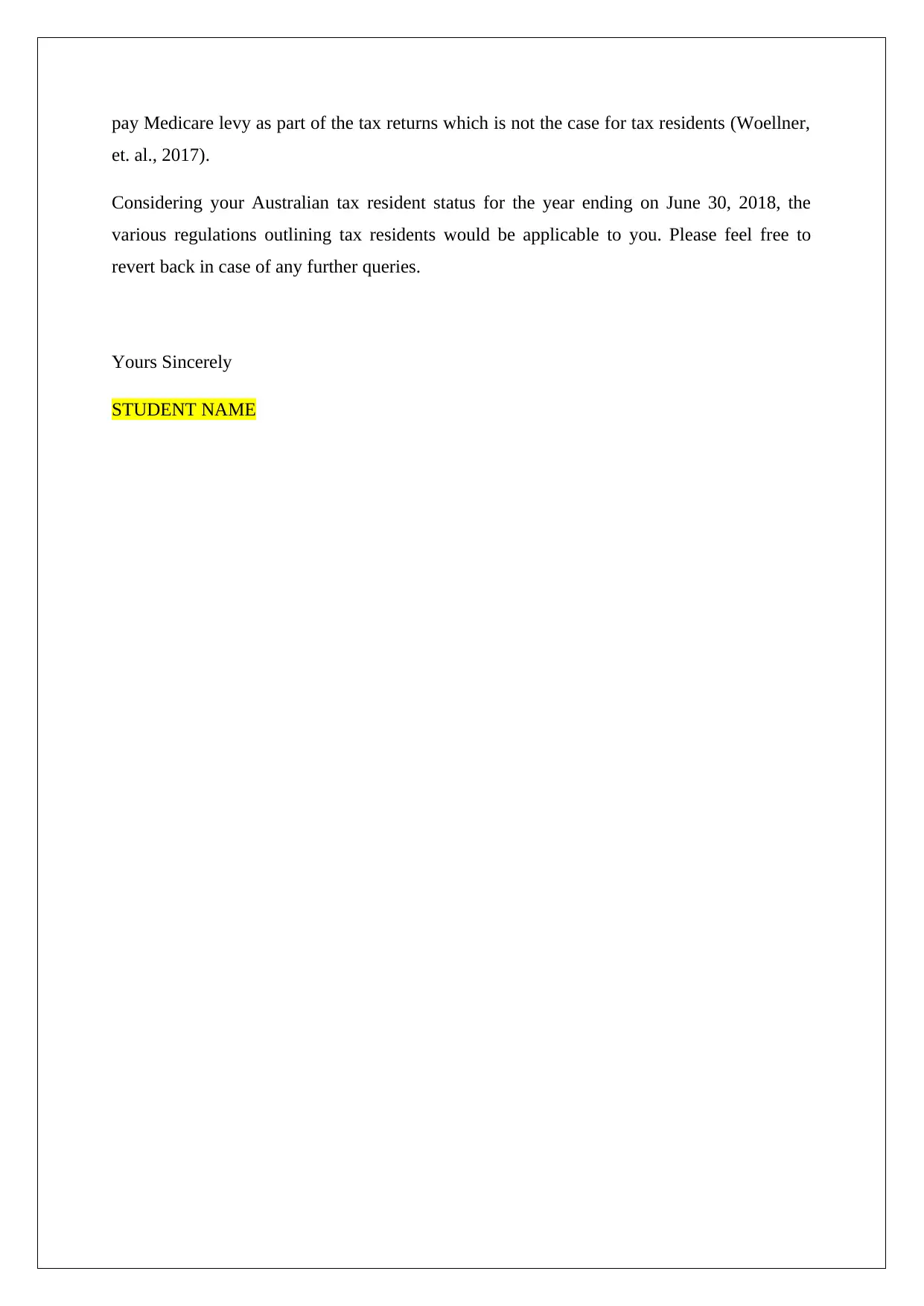
pay Medicare levy as part of the tax returns which is not the case for tax residents (Woellner,
et. al., 2017).
Considering your Australian tax resident status for the year ending on June 30, 2018, the
various regulations outlining tax residents would be applicable to you. Please feel free to
revert back in case of any further queries.
Yours Sincerely
STUDENT NAME
et. al., 2017).
Considering your Australian tax resident status for the year ending on June 30, 2018, the
various regulations outlining tax residents would be applicable to you. Please feel free to
revert back in case of any further queries.
Yours Sincerely
STUDENT NAME
Paraphrase This Document
Need a fresh take? Get an instant paraphrase of this document with our AI Paraphraser
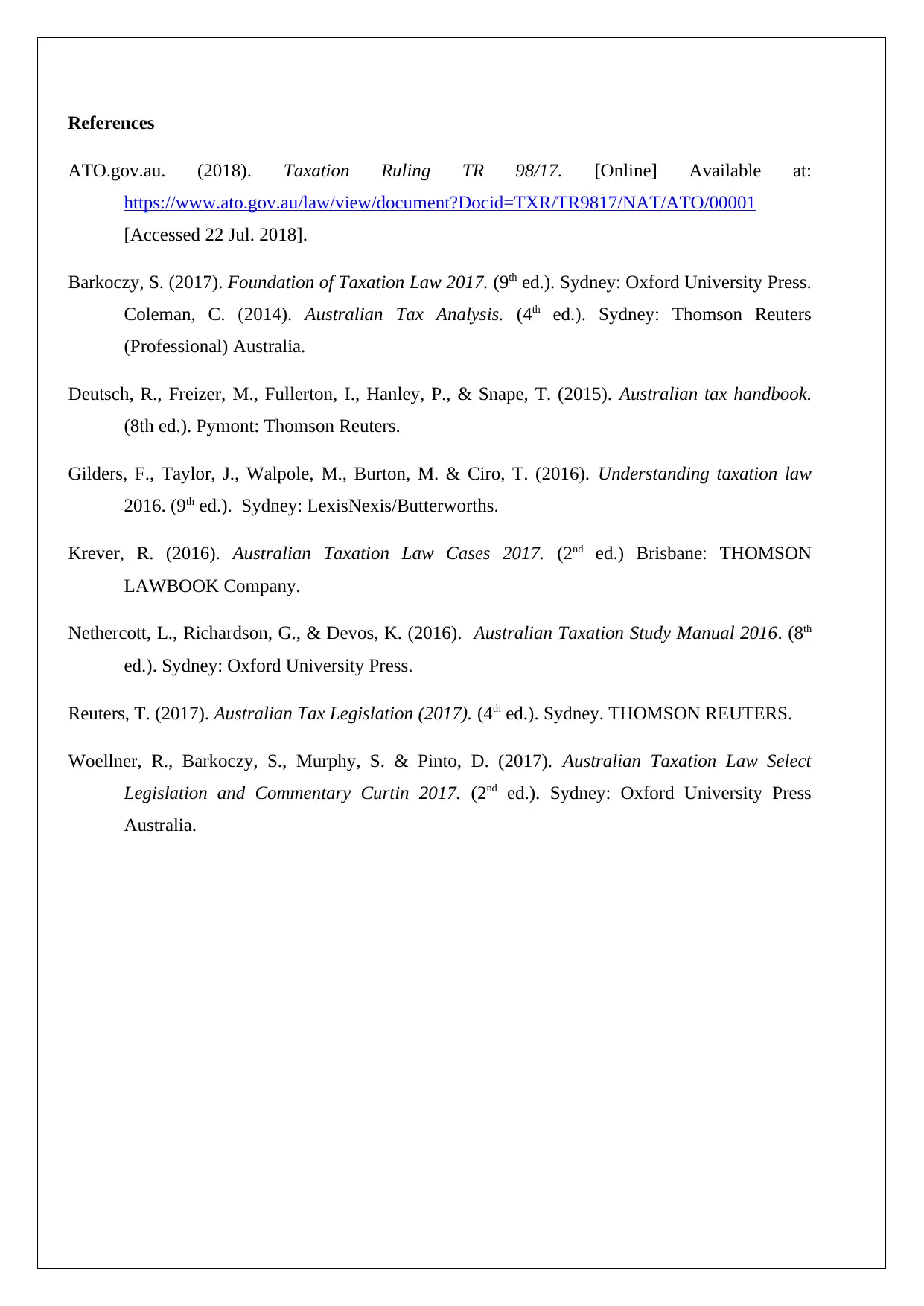
References
ATO.gov.au. (2018). Taxation Ruling TR 98/17. [Online] Available at:
https://www.ato.gov.au/law/view/document?Docid=TXR/TR9817/NAT/ATO/00001
[Accessed 22 Jul. 2018].
Barkoczy, S. (2017). Foundation of Taxation Law 2017. (9th ed.). Sydney: Oxford University Press.
Coleman, C. (2014). Australian Tax Analysis. (4th ed.). Sydney: Thomson Reuters
(Professional) Australia.
Deutsch, R., Freizer, M., Fullerton, I., Hanley, P., & Snape, T. (2015). Australian tax handbook.
(8th ed.). Pymont: Thomson Reuters.
Gilders, F., Taylor, J., Walpole, M., Burton, M. & Ciro, T. (2016). Understanding taxation law
2016. (9th ed.). Sydney: LexisNexis/Butterworths.
Krever, R. (2016). Australian Taxation Law Cases 2017. (2nd ed.) Brisbane: THOMSON
LAWBOOK Company.
Nethercott, L., Richardson, G., & Devos, K. (2016). Australian Taxation Study Manual 2016. (8th
ed.). Sydney: Oxford University Press.
Reuters, T. (2017). Australian Tax Legislation (2017). (4th ed.). Sydney. THOMSON REUTERS.
Woellner, R., Barkoczy, S., Murphy, S. & Pinto, D. (2017). Australian Taxation Law Select
Legislation and Commentary Curtin 2017. (2nd ed.). Sydney: Oxford University Press
Australia.
ATO.gov.au. (2018). Taxation Ruling TR 98/17. [Online] Available at:
https://www.ato.gov.au/law/view/document?Docid=TXR/TR9817/NAT/ATO/00001
[Accessed 22 Jul. 2018].
Barkoczy, S. (2017). Foundation of Taxation Law 2017. (9th ed.). Sydney: Oxford University Press.
Coleman, C. (2014). Australian Tax Analysis. (4th ed.). Sydney: Thomson Reuters
(Professional) Australia.
Deutsch, R., Freizer, M., Fullerton, I., Hanley, P., & Snape, T. (2015). Australian tax handbook.
(8th ed.). Pymont: Thomson Reuters.
Gilders, F., Taylor, J., Walpole, M., Burton, M. & Ciro, T. (2016). Understanding taxation law
2016. (9th ed.). Sydney: LexisNexis/Butterworths.
Krever, R. (2016). Australian Taxation Law Cases 2017. (2nd ed.) Brisbane: THOMSON
LAWBOOK Company.
Nethercott, L., Richardson, G., & Devos, K. (2016). Australian Taxation Study Manual 2016. (8th
ed.). Sydney: Oxford University Press.
Reuters, T. (2017). Australian Tax Legislation (2017). (4th ed.). Sydney. THOMSON REUTERS.
Woellner, R., Barkoczy, S., Murphy, S. & Pinto, D. (2017). Australian Taxation Law Select
Legislation and Commentary Curtin 2017. (2nd ed.). Sydney: Oxford University Press
Australia.
1 out of 5
Related Documents
Your All-in-One AI-Powered Toolkit for Academic Success.
+13062052269
info@desklib.com
Available 24*7 on WhatsApp / Email
![[object Object]](/_next/static/media/star-bottom.7253800d.svg)
Unlock your academic potential
Copyright © 2020–2025 A2Z Services. All Rights Reserved. Developed and managed by ZUCOL.





